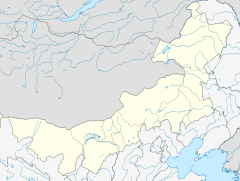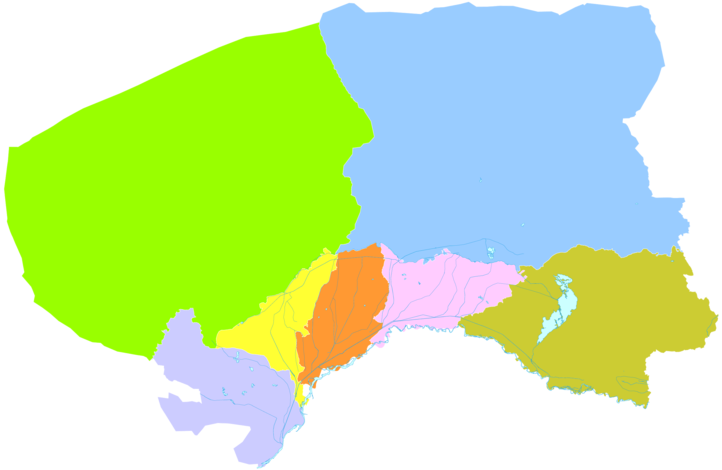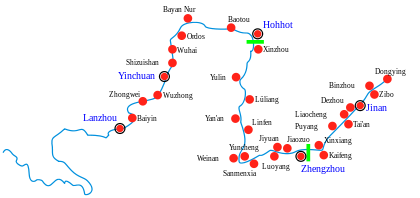Prefecture-level city in Inner Mongolia, People's Republic of China
Bayannur
巴彦淖尔市 • ᠪᠠᠶᠠᠨᠨᠠᠭᠤᠷ ᠬᠣᠲᠠ
Linhe District, the seat of Bayannur
Location of Bayannur City jurisdiction in Inner Mongolia
Location of the city centre in Inner Mongolia
Coordinates (Bayannur municipal government): 40°44′35″N 107°23′13″E / 40.743°N 107.387°E / 40.743; 107.387 Country People's Republic of China Region Inner Mongolia Municipal seat Linhe District • CPC Secretary Nashunmenghe • Mayor He Yonglin • Prefecture-level city 65,788 km2 (25,401 sq mi) • Urban 80.51 km2 (31.09 sq mi) • Districts [1] 2,354.0 km2 (908.9 sq mi) • Prefecture-level city 1,669,915 • Density 25/km2 (66/sq mi) • Urban 385,700 • Urban density 4,800/km2 (12,000/sq mi) • Districts[1]
608,000 • Prefecture-level city CN¥ 88.7 billionUS$ 14.2 billion • Per capita CN¥ 52,987 Time zone UTC+8 (China Standard )Postal code 015000
Area code 0478 ISO 3166 code CN-NM-08 Website bynr.gov.cn
Bayannur or Bayannao'er (Chinese : 巴彦淖尔市 ; pinyin : bāyànnàoěr Mongolian : Bayannaɣur qota , Mongolian Cyrillic Баяннуур хот) is a prefecture-level city in western Inner Mongolia , People's Republic of China. Until 1 December 2003, the area was called Bayannur League .
Bayannur has an administrative area of 65,788 km2 (25,401 sq mi). The name of the city in Mongolian means "Rich Lake". As of the 2010 census, the population of Bayannur was 1,669,915; while the city proper, Linhe District, had 520,300 inhabitants.[3]
The city is served by the Bayannur Tianjitai Airport .
History
The Zhao dynasty (403 BCE–222 BCE) controlled an area including modern-day Bayannur, while the Western Han dynasty (206 BCE–24 CE) established a hierarchical Chinese administrative structure. The Qing dynasty (1644–1912) designated this area as part of "Inner Mongolia", but after its overthrow by the Republic of China (1912–1949) , Bayannur was assigned to Suiyuan Province . Because of Mongol-Chinese cooperation with the Communist faction in the Chinese Civil War (stalled since 1950), Suiyuan was annexed to the new Inner Mongolia Autonomous Region from 1954, although not without controversy because of the province's large and longstanding ethnic Han majority.[citation needed
Geography and climate
Bayannur is located in the western part of inner Mongolia Autonomous region. Neighbouring prefectures are:
It also borders Mongolia to the north. The whole area of the prefecture is 65,788 km2 (25,401 sq mi) at present and the total population is nearly 1.7 million. Bayannur features a desert climate (Köppen BWk ), marked by long, cold and very dry winters, very warm, somewhat humid summers, and strong winds, especially in spring. Most of the rain falls between July and September, with very little snow in winter.
Climate data for Bayannur (Linhe District ), elevation 1,041 m (3,415 ft), (1991–2020 normals, extremes 1956–2010)
Month
Jan
Feb
Mar
Apr
May
Jun
Jul
Aug
Sep
Oct
Nov
Dec
Year
Record high °C (°F)
12.3
16.9
24.2
33.3
36.6
39.1
39.4
37.9
36.0
29.9
20.2
12.4
39.4
Mean daily maximum °C (°F)
−3.1
2.5
10.0
18.5
24.8
29.4
31.1
28.9
23.8
16.1
6.2
−1.4
15.6
Daily mean °C (°F)
−9.4
−4.7
2.9
11.3
17.8
22.9
24.8
22.5
16.7
8.8
0.2
−7.1
8.9
Mean daily minimum °C (°F)
−14.5
−10.4
−3.1
4.3
10.7
16.2
18.7
16.7
10.7
3.1
−4.3
−11.6
3.0
Record low °C (°F)
−35.3
−32.4
−19.1
−10.3
−3.1
5.5
9.0
5.1
−2.0
−9.6
−20.0
−27.0
−35.3
Average precipitation mm (inches)
0.8
1.3
3.5
4.7
14.4
21.7
28.4
37.6
23.3
6.6
2.5
0.9
145.7
Average precipitation days (≥ 0.1 mm)
1.0
0.8
1.5
1.6
3.7
5.1
7.0
7.0
5.0
1.9
1.0
1.0
36.6
Average snowy days
2.0
1.4
1.3
0.4
0.1
0.0
0.0
0.0
0.0
0.3
1.2
1.7
8.4
Average relative humidity (%)
53
44
37
31
34
41
52
56
54
50
53
52
46
Mean monthly sunshine hours
213.8
218.0
259.0
279.9
313.5
306.6
304.5
291.6
260.3
261.5
217.1
201.7
3,127.5
Percent possible sunshine
71
72
69
70
70
68
67
69
71
77
74
70
71
Source 1: China Meteorological Administration [4] [5]
Source 2: Weather China[6]
Demographics
In 2000, there were 1,682,662 inhabitants:
At the end of 2004, the population was at around 1.79 million inhabitants.
Administrative subdivisions
Bayannur is divided into one district, two counties and four banners :
Map
Name
Mongolian
Hanzi
Hanyu Pinyin
Population (2010)
Area (km2 )
Density (/km2 )
Linhe District
ᠯᠢᠨᠾᠧ ᠲᠣᠭᠣᠷᠢᠭ (Linhė toɣoriɣ)
临河区 Línhé Qū
541,721
2,354
230
Wuyuan County
ᠦᠶᠤᠸᠠᠨ ᠰᠢᠶᠠᠨ (Üyuvan siyan)
五原县 Wǔyuán Xiàn
260,480
2,493
104
Dengkou County
ᠳ᠋ᠧᠩᠺᠧᠦ ᠰᠢᠶᠠᠨ (Dėŋḵėü siyan)
磴口县 Dèngkǒu Xiàn
117,091
4,167
28
Urad Front Banner ᠤᠷᠠᠳ ᠤᠨ ᠡᠮᠦᠨᠡᠳᠦ ᠬᠣᠰᠢᠭᠤ (Urad-un Emünedü qosiɣu)
乌拉特前旗 Wūlātè Qián Qí
293,269
7,476
39
Urad Middle Banner ᠤᠷᠠᠳ ᠤᠨ ᠳᠤᠮᠳᠠᠳᠤ ᠬᠣᠰᠢᠭᠤ (Urad-un Dumdadu qosiɣu)
乌拉特中旗 Wūlātè Zhōng Qí
134,204
22,606
6
Urad Rear Banner ᠤᠷᠠᠳ ᠤᠨ ᠬᠣᠶᠢᠲᠤ ᠬᠣᠰᠢᠭᠤ (Urad-un Qoyitu qosiɣu)
乌拉特后旗 Wūlātè Hòu Qí
65,207
24,925
2
Hanggin Rear Banner ᠬᠠᠩᠭᠢᠨ ᠬᠣᠶᠢᠲᠤ ᠬᠣᠰᠢᠭᠤ (Qaŋɣin Qoyitu qosiɣu)
杭锦后旗 Hángjǐn Hòu Qí
257,943
1,767
145
Cuisine
Located in Hetao Plain, Bayannaoer is the largest agricultural hub in Inner Mongolia. Bayannaoer is famous for "Bameng braised dishes" (巴盟烩菜


![]() Bayannaɣur qota, Mongolian Cyrillic Баяннуур хот) is a prefecture-level city in western Inner Mongolia, People's Republic of China. Until 1 December 2003, the area was called Bayannur League.
Bayannaɣur qota, Mongolian Cyrillic Баяннуур хот) is a prefecture-level city in western Inner Mongolia, People's Republic of China. Until 1 December 2003, the area was called Bayannur League.


